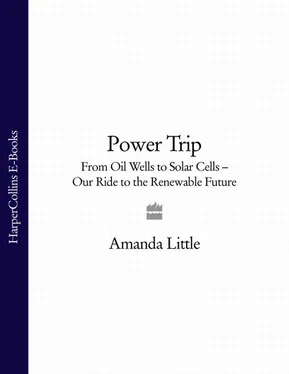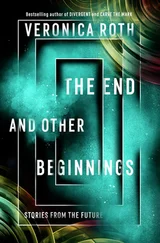The focus of my reporting pinballed from the digital revolution to what seemed a bigger, more urgent shift—the wholesale rebuilding of our energy landscape. Fancying myself an amateur detective, I started traveling throughout the country, from Ashland, Oregon, to Tampa Bay, Florida, to write about the architects and early adopters of emerging energy technologies that could provide alternatives to fossil fuels: solar, wind, geothermal, biofuels, and hybrid-electric cars such as the Toyota Prius. I began studying and writing about the legislation that was being drafted (and blocked) to push these innovations into the mainstream. I began criticizing the federal government’s failure to take action on climate change and its unwillingness to encourage the development of clean, efficient, next-generation energy technologies.
But when the August 2003 blackout hit, I realized one major blind spot in my understanding of energy. Nothing I’d learned in my reporting had quite prepared me for the feeling of utter helplessness and paralysis that a blackout of that scale would cause. It was the first time, for me and for millions of Americans, that the story of energy was conveyed in human terms. Here I was crisscrossing the country, chasing after innovators and wagging fingers at the government, but I’d completely neglected to examine the role of energy in my own life. One morning I began with a seemingly simple task: I took a much smaller and quieter, but for me equally momentous, tour around my office. My aim was to count the things in my midst that were, in one way or another, tied to fossil fuels.
Oil, coal, and natural gas—the three most common forms of fossil fuels—were all formed over a period of millions of years from the remains of plants and animals (primarily tiny aquatic organisms) that were exposed to the combined effects of time, compression, and temperature. Oil accounts for roughly half of our nation’s total fossil fuel usage. What it provides, by and large, is movement—America’s transportation sector is almost entirely dependent on petroleum (a term used interchangeably with oil , referring to its raw, unrefined state). Petroleum is chemically complex and can be refined not just into gasoline, kerosene, and motor oil but also into the petrochemicals that are the basic building blocks of a vast range of consumer products, from plastic bags to bulletproof vests.
What petroleum doesn’t provide is electricity, which accounts for the other half of America’s fossil fuel use. Electricity generation can be broken down into three main sources: coal (about 50 percent), natural gas (20 percent), and nuclear (20 percent). Natural gas is essentially petroleum that has been slow-cooked over time into a gaseous form.
Despite their many different applications, fossil fuels have a common purpose. My Merriam-Webster dictionary defines energy as “the ability to do work,” and fossil fuels have been doing America’s industrial work for more than a century. When I refer to America’s “energy landscape,” I’m talking about the whole picture—the combination of oil, coal, and natural gas that feeds the intricate organism of modern society. That feeds our own lives—my own life, as I realized that morning while conducting my amateur fossil fuel audit.
Since nearly all plastics, polymers, inks, paints, fertilizers, and pesticides are made from petrochemicals, and all products are delivered to market by trucks, trains, ships, and airplanes, there was virtually nothing in my office—my body included—that wasn’t there because of fossil fuels.
There I sat at a desk made of Formica (a plastic), wearing a sweatshirt made of fleece (a polymer) over yoga pants made from Lycra (ditto), sipping coffee shipped from Zimbabwe, eating an apple trucked from Washington, surrounded by walls covered with oil-derived paints, jotting notes in petroleum-derived ink, typing words on a petrochemical keyboard into a computer powered by coal plants. Even the supposedly guilt-free wholegrain cereal I had for breakfast and the veggie burger I ate for lunch came from crops treated with oil-derived fertilizers. My purse yielded another trove of specimens: capsules of Extra-Strength Tylenol made from acetaminophen (a substance, like many commercial pain relievers, that is refined from petroleum); glossy magazines and a packet of photographs printed with petrochemicals; mascara, lip balm, eyeliner, and perfume that, like most cosmetics, have key components derived from oil.
I had understood this intellectually before—that the energy landscape encompasses not just our endless acres of oil fields, coal mines, gas stations, and highways, as well as the vast network of copper wires that feeds electricity to our homes and offices. It’s also the cornfields in America’s heartland, the battlefields of Iraq, and the medical labs that produce penicillin, novocaine, chemotherapy drugs, and many other treatments and cures. It’s the cosmetics shelves and glossy magazine racks in our drugstores. It’s the constantly humming, behind-the-scenes network of ships, planes, trains, and trucks that transport products to our store shelves. It’s even our own bodies, which we routinely drape in synthetic fabrics like spandex and nylon, and feed with crops that were fertilized by fossil fuels.
What I hadn’t fully managed to grasp was the intimate and invisible omnipresence of fossil fuels in my own life—the plastic sutures that stitched up my split lip when I was seven, the photographic CAT scan images that evaluated my concussion after an accident when I was twenty-seven. Once I connected the dots between so many seemingly disparate elements of my life—my car, my clothes, my e-mail, my makeup, my burger, even my health—I saw an energy landscape far more vast and complex than I’d ever imagined.
I also realized that this thing I’d thought was a four-letter word (oil) was actually the source of many creature comforts I use and love—and many survival tools I need. It seemed almost miraculous. Never had I so fully grasped the immense versatility of fossil fuels on a personal level and their greater relevance in the economy at large.
Energy, I realized that morning, is everything. It’s life, liberty, the pursuit of happiness—and our very survival. But if fossil fuels are a part of everything we do, how do we go about removing them from the picture? How can we kick America’s addiction to fossil fuels, given its sheer magnitude? And what will our success or failure in transforming our energy landscape mean to the world at large?
What I’d been chasing ever since my first efforts at reporting, as I tried to make sense of the power grid, September 11, the 2003 blackout, and the role of fossil fuels in daily life, was connections—the ways in which energy connects us all, beyond our homes, our cities, our state and national borders. Energy is the thread from which our modern lives dangle, but it is an invisible thread—pumped through underwater oil pipelines, coursing through unseen cables in remote meadows, and tucked away in basement fuse boxes, just as the veins are hidden beneath our skin.
It is common knowledge now that America’s energy-dependent economy is facing radical change. We are in the midst of economic, geopolitical, and environmental turmoil—a triple threat that is deeply rooted in our use of fossil fuels. Many countries face these issues, but Americans stand to lose more than the people of any other nation given our formidable appetite for energy. Last year, we used roughly 25 barrels of oil per person; Europeans, by comparison, used 17, and the citizens of Japan used just 14.
Nevertheless, we are reminded as frequently by ExxonMobil commercials as we are by White House officials and eco-activists that our nation has begun the shift away from ancient energy sources toward cleaner, homegrown sources of power and fuel. We regularly hear menacing threats and utopian promises—on the one hand, global warming is well on its way to producing irreversible coastal floods and mega-drought, and we are in the throes of an “energy crisis”; on the other, we are in “an era of change,” heading toward a “green revolution.” We are told that the global recession we’ve faced in recent years is an opportunity to reengineer our industries and infrastructure with green technology. “We will rebuild, we will recover,” President Obama has said, “and the United States of America will emerge stronger than before.” He has vowed to “lay a new foundation for economic growth by beginning a new era of energy exploration in America.” We are promised a future in which solar panels will glitter across rooftops, wind turbines will whirl across prairies, super-efficient cars will glide silently along our roads, and new clean industries will provide millions of jobs to a “green-collar” workforce that will repair our aging infrastructure and revive our struggling economy.
Читать дальше












